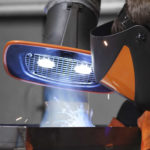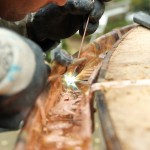Welding aluminium: dangerous formation of oxides and ozone
Many welding companies ask themselves one question when it comes to the welding of aluminium: Is an air pollution control system absolutely necessary when working with this comparatively lightweight material? Studies show, however, that the material does indeed pose a major risk, and the formation of ozone in particular should encourage companies to put ventilation measures in place.
As a general rule, the following points apply in relation to aluminium: All materials are suitable for welding. However, the following also applies: When welding aluminium materials, aluminium oxide is formed from the filler material and the base material. This aluminium-oxygen compounds are present in the welding fumes. The oxide occurs in the form of spherical particles, from a minimum of 10 to 50 or up to 400 nanometres depending on the welding method being used.
Risk of irreversible aluminosis
Breathing in these particles can put a strain on the respiratory tracts and even the lungs if the particles reach and are deposited there. Respiratory diseases such as bronchitis can occur as a result of this harmful substance. The dust deposits can even bring about irreversible aluminosis, also known as aluminium lung.
The issue is an important one: In Germany, for example, this type of aluminosis is one of the occupational diseases for which compensation can be claimed. The actual damage that occurs has less to do with the duration of exposure, and more with the intensity. The general dust emission limits also apply to aluminium oxide.
Ozone: the hidden danger
Metal-inert-gas welding (MIG) and Wolfram-inert-gas welding (WIG) are the preferred methods when working with aluminium materials. The reasons for this are as follows: When it comes to the aluminium smelt, the material tends to react with the atmosphere, meaning that inert gases need to be used. However, the combination of the aluminium material and the MIG or WIG welding method creates a different harmful substance: ozone. This occurs as a result of the ultraviolet radiation from the oxygen in the air. The UV rays are then reflected on the bare aluminium surfaces, and can still form ozone even at somewhat of a distance from the weld. This creates not only the particulate welding fumes themselves, but also a highly dangerous gas.
Ozone occurs in particular in situations where there are few welding fumes, as is the case with MIG and WIG, the typical aluminium welding methods. When MIG-welding aluminium-silicon alloys, the ozone concentrations are higher than those formed when welding pure aluminium, for example, and significantly higher than when welding aluminium-magnesium materials. And with WIG-welding too, the low fume development also encourages ozone formation. As clarification: The low levels of fume development mean that the UV rays can easily spread out. Ozone is also unstable, and fumes or dust would encourage its decomposition into oxygen, which does not occur if there are only low levels of fume development.
Risk of cancer due to aluminium welding
In addition to the substantial risks posed by the formation of aluminium oxide during aluminium welding, ozone can also have an even more devastating effect for the welder. Ozone is classified as carcinogenic according to TRGS 905 [Technical Rules for Hazardous Substances]. Because the hazardous substances that develop during the welding of aluminium materials fall under the limit values, protective measures must be taken, According to the data sheet from the German Social Accident Insurance, ten times as much ozone is produced during MIG welding as during WIG welding. However, WIG welding is significantly slower and therefore more expensive, so changing the welding method does not always achieve the desired effects. As a result, technical measures are preferable, in particular the suction-removal of welding fumes and gases at their places of origin.





